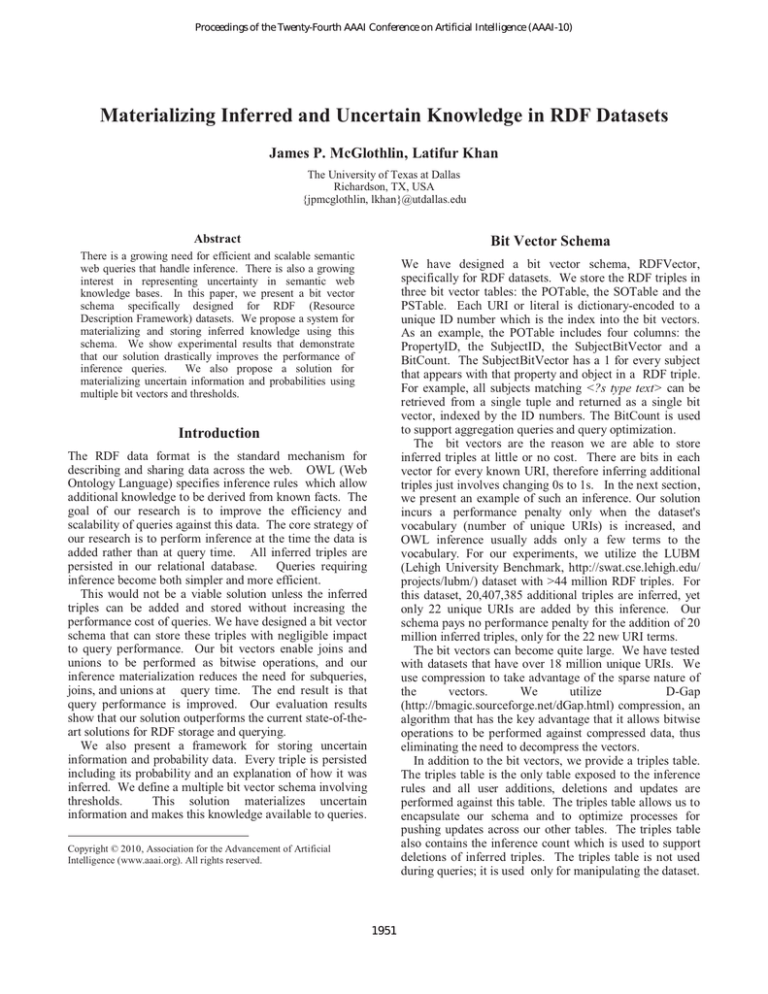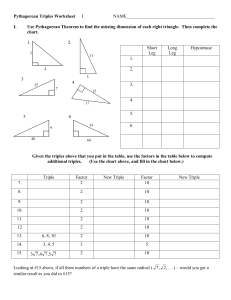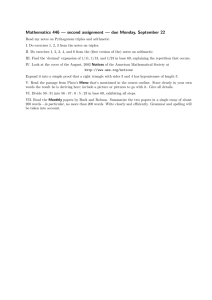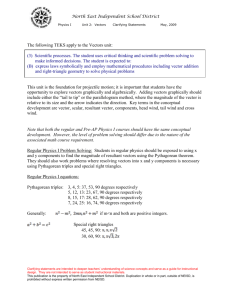
Proceedings of the Twenty-Fourth AAAI Conference on Artificial Intelligence (AAAI-10)
Materializing Inferred and Uncertain Knowledge in RDF Datasets
James P. McGlothlin, Latifur Khan
The University of Texas at Dallas
Richardson, TX, USA
{jpmcglothlin, lkhan}@utdallas.edu
Abstract
Bit Vector Schema
There is a growing need for efficient and scalable semantic
web queries that handle inference. There is also a growing
interest in representing uncertainty in semantic web
knowledge bases. In this paper, we present a bit vector
schema specifically designed for RDF (Resource
Description Framework) datasets. We propose a system for
materializing and storing inferred knowledge using this
schema. We show experimental results that demonstrate
that our solution drastically improves the performance of
inference queries.
We also propose a solution for
materializing uncertain information and probabilities using
multiple bit vectors and thresholds.
We have designed a bit vector schema, RDFVector,
specifically for RDF datasets. We store the RDF triples in
three bit vector tables: the POTable, the SOTable and the
PSTable. Each URI or literal is dictionary-encoded to a
unique ID number which is the index into the bit vectors.
As an example, the POTable includes four columns: the
PropertyID, the SubjectID, the SubjectBitVector and a
BitCount. The SubjectBitVector has a 1 for every subject
that appears with that property and object in a RDF triple.
For example, all subjects matching <?s type text> can be
retrieved from a single tuple and returned as a single bit
vector, indexed by the ID numbers. The BitCount is used
to support aggregation queries and query optimization.
The bit vectors are the reason we are able to store
inferred triples at little or no cost. There are bits in each
vector for every known URI, therefore inferring additional
triples just involves changing 0s to 1s. In the next section,
we present an example of such an inference. Our solution
incurs a performance penalty only when the dataset's
vocabulary (number of unique URIs) is increased, and
OWL inference usually adds only a few terms to the
vocabulary. For our experiments, we utilize the LUBM
(Lehigh University Benchmark, http://swat.cse.lehigh.edu/
projects/lubm/) dataset with >44 million RDF triples. For
this dataset, 20,407,385 additional triples are inferred, yet
only 22 unique URIs are added by this inference. Our
schema pays no performance penalty for the addition of 20
million inferred triples, only for the 22 new URI terms.
The bit vectors can become quite large. We have tested
with datasets that have over 18 million unique URIs. We
use compression to take advantage of the sparse nature of
the
vectors.
We
utilize
D-Gap
(http://bmagic.sourceforge.net/dGap.html) compression, an
algorithm that has the key advantage that it allows bitwise
operations to be performed against compressed data, thus
eliminating the need to decompress the vectors.
In addition to the bit vectors, we provide a triples table.
The triples table is the only table exposed to the inference
rules and all user additions, deletions and updates are
performed against this table. The triples table allows us to
encapsulate our schema and to optimize processes for
pushing updates across our other tables. The triples table
also contains the inference count which is used to support
deletions of inferred triples. The triples table is not used
during queries; it is used only for manipulating the dataset.
Introduction
The RDF data format is the standard mechanism for
describing and sharing data across the web. OWL (Web
Ontology Language) specifies inference rules which allow
additional knowledge to be derived from known facts. The
goal of our research is to improve the efficiency and
scalability of queries against this data. The core strategy of
our research is to perform inference at the time the data is
added rather than at query time. All inferred triples are
persisted in our relational database. Queries requiring
inference become both simpler and more efficient.
This would not be a viable solution unless the inferred
triples can be added and stored without increasing the
performance cost of queries. We have designed a bit vector
schema that can store these triples with negligible impact
to query performance. Our bit vectors enable joins and
unions to be performed as bitwise operations, and our
inference materialization reduces the need for subqueries,
joins, and unions at query time. The end result is that
query performance is improved. Our evaluation results
show that our solution outperforms the current state-of-theart solutions for RDF storage and querying.
We also present a framework for storing uncertain
information and probability data. Every triple is persisted
including its probability and an explanation of how it was
inferred. We define a multiple bit vector schema involving
thresholds.
This solution materializes uncertain
information and makes this knowledge available to queries.
Copyright © 2010, Association for the Advancement of Artificial
Intelligence (www.aaai.org). All rights reserved.
1951
We propagate the probabilities throughout the system
based on the simple Bayesian logic rule that P(A)=
P(A|B)*P(B). We recognize that there can be ambiguities
when 2 inference rules attempt to add the same triple with
different probabilities. Our goal in this framework is not to
solve such ambiguities. We support and register exception
handlers to enable flexibility and to allow existing
reasoning technologies to be used. Our contribution is that
once the probabilities are calculated they can be persisted
and made available for efficient querying.
Inference
Consider the triple <Professor0 type FullProfessor>. The
LUBM ontology will allow us to infer 4 additional triples:
<Professor0 type Professor>, <Professor0 type Faculty>,
<Professor0 type Employee>, <Professor0 type Person>.
Our strategy is to materialize and store all 4 inferred
triples. As Professor, Faculty, Employee and Person exist
elsewhere in the dataset, no new vocabulary is introduced.
All that is required to add these triples to the bit vector
tables is to change 0s to 1s in the vectors; the size of the bit
vectors is not increased. Now, we can execute a query
such as List all persons by reading a single bit vector. To
query all persons with vertical partitioning (Abadi et al.,
2007) or RDF-3X (Neumann&Weikum, 2008) would
require 21 subqueries and 20 unions.
We provide an inference engine to register and manage
inference rules. When a triple is added to the triples table,
the inference engine iterates through the inference rules
and allows each rule to add inferred triples. We have
implemented inference rules for all OWL constructs.
Deletions offer a special challenge for inferred triples. If
the base triple is deleted, then any inferred triples should
be deleted as well. However, a triple might be inferred
from more than one base triple. We solve this problem by
maintaining an inference count in the triples table, and only
deleting the inferred triple when the count becomes 0.
Evaluation Results
Due to space limitations, we only present a summary of
our results for one dataset (LUBM) for the queries
involving inference. We compared with RDF-3X and
vertical partitioning. All of our experiments here were
performed on a Dell M6400 laptop with 8GB RAM. Our
run times for LUBM (for the 44 million triples dataset) are:
Q3
Time(sec)
Threshold
SubjectBitVector
hasDisease
hasDisease
hasDisease
hasDisease
LungCancer
LungCancer
LungCancer
LungCancer
1.0
0.75
0.5
0.25
101001010100100000
101101010101100001
111101010101101011
111101110101101011
Q6
0.23
0.14
Q11
Q13
0.24
0.21
The %improvement is in comparison to the next fastest
solution for that query. In most cases, this is RDF-3X.
LUBM Query 5: List persons who are members of a
particular department. This query invokes five kinds of
inference rules. Since our solution materialized the
inferred triples, we can just query the POTable. We
retrieve the tuples for property=type, object=Person and
property=memberOf, object=Department0, and execute
the bit operation and between the bit vectors. We are able
to perform this query in 0.23 seconds. RDF-3X requires
2.88 seconds and vertical partitioning requires 56.28.
OWL has provable inference. All inferred triples are
known to be true with absolute certainty. Uncertainty
reasoning addresses the issue of knowledge that might be
true. Our goal is to associate probability numbers with
facts (RDF triples) in the database. There is no standard
for representing probability in an ontology. Our goal is not
to restrict the ontology representation. Therefore, as with
provable inference, we allow inference rules to register.
To support probability, we modify the triples table and
the bit vector tables. For the triples table, we add extra
columns for the probability and an explanation of the
inference. For the bit vector tables, we add a threshold
column. The vectors become bit vectors with 1s for every
triple known with probability>=threshold. For vectors
without probability, the threshold is 1.
Below is an
example POTable with probabilities and thresholds:
Object
Q5
%Improvement 67.4% 98.0% 60.8% 84.7% 81.1%
Uncertainty Reasoning
Property
0.15
Future Work
In the future, we plan to identify or create large
benchmarks to test our uncertainty solution for scalability
and efficiency. We also plan to improve our framework
for handling ambiguities and to integrate with available
ontology tools such as BayesOWL and PR-OWL.
References
Abadi, D.J.; Marcus, A.; Madden, S.; Hollenbach, K.J. 2007.
Scalable Semantic Web Data Management Using Vertical
Partitioning. In Proc. of VLDB, 411-422.
Weiss, C.; Karras, P.; Bernstein, A. 2008. Hexastore: sextuple
indexing for semantic web data management. In Proc. of
VLDB, 1008-1019.
Neumann, T.; Weikum, G. 2008. RDF-3X: a RISC-style engine
for RDF. In Proc. of VLDB, 647-659.
Costa, P.C.G.D.; Laskey, K.B.; Laskey, K.J. 2008. PR-OWL: A
Bayesian Ontology Language for the Semantic Web. In Proc.
of URSW, 88-107.
Ding, Z.; Peng, Y. 2004. A Probabilistic Extension to Ontology
Language OWL. In Proc. of HICSS.
Count
6
9
12
13
We can now retrieve all subjects with >0.5 probability of
having lung cancer by reading a single tuple, and we can
still use bitwise operations to join vectors. If a query
requests a different probability than provided by the
threshold, we use the bit vectors for efficient selection and
then we access the triples table for precise comparison.
1952






